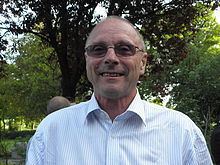John O’Sullivan is an Australian electrical engineer whose work in the application of Fourier transforms to radio astronomy led to his invention with colleagues of a core technology that made wireless LAN fast and reliable. This technology was patented by CSIRO and forms part of the 802.11a, 802.11g and 802.11n Wi-Fi standards and thus John O'Sullivan is also credited with the invention of WIFI.
In 2009 O’Sullivan was awarded both the CSIRO Chairman’s Medal and the Australian Prime Minister's Prize for Science.
He is currently working on the design of the Australian Square Kilometre Array Pathfinder telescope, a step towards the proposed Square Kilometre Array telescope.
In 1977 John O'Sullivan co-authored a paper in the Journal of the Optical Society of America titled "Image sharpness, Fourier optics, and redundant-spacing interferometry" with J. P. Hamaker, and J. E. Noordam. In this paper, they presented a technique for sharpening and improving picture clarity in radio astronomy images.
In the early 1990s, O'Sullivan led a team at the CSIRO which patented in 1996 the use of a related technique for reducing multipath interference of radio signals transmitted for computer networking. This technology is a part of all recent WiFi implementations. As of April 2012, the CSIRO has earned over $430 million in royalties and settlements arising from the use of this patent as part of the 802.11 standards with as much as a billion dollars expected after further lawsuits against other parties.
1974 Doctor of Philosophy (Electrical Engineering), Sydney University 1969 Bachelor of Engineering, H1, University Medal, Sydney University1969 Sydney University Sports Blue (Hockey)1967 Bachelor of Science, Sydney UniversityCareer highlights, awards, fellowships and grants
2017 The IEEE Masaru Ibuka Consumer Electronics Award (with David Skellern) "for pioneering contributions to high-speed wireless LAN technology."2012 The European Inventor Award 2012 awarded by European Patent Office for having "made the wireless LAN as fast and powerful as the cabled solutions of the time, and is the basis for the wireless networking technology (Wi-Fi) now used in billions of devices worldwide." 2012 Fellow of Australian Academy of Technological Sciences and Engineering2010 Fellow of Australian Academy of Science2009 Prime Minister's Prizes for Science2009 CSIRO Chairman’s Medal2005–present Systems Engineer, CSIRO Australia Telescope National Facility2004–2006 Lead Signal Processing Architect, G2 Microsystems2001–2004 Director IC Systems Engineering, Cisco Systems2000 CSIRO Medal for development and application of fast Fourier transform technology1999–2001 Vice President Systems Engineering, Radiata Communications1995–2000 Director Technology, News Ltd1989–1995 Deputy Chief of Division, CSIRO Radiophysics1983–1989 Head of Signal Processing Group, CSIRO Radiophysics1974–1983 Head of Receiver Group, Netherlands Foundation for Radio Astronomy (now ASTRON)Achieved an eight-fold increase of the bandwidth processing capacity of the Westerbork Radio Telescope as project leader for the digital continuum backend receiverParticipated in a series of innovative experiments to detect exploding black holes artnd other short time astronomical eventsDeveloped an intellectual underpinning for adaptive optics in light telescopes and redundant baseline interferometer in radio telescopesWith Austek Microsystems created a fast Fourier transform computer chip. This VLSI chip consisted of 160,000 transistors and performed real time transforms at rates up to 2.5 Msamples/sInfluential role in the system design for the Australia TelescopeLed a CSIRO team comprising Graham Daniels, John Deane, Diethelm Ostry, Terry Percival who together invented a patented technology that uses fast Fourier transform and other techniques to enable fast, robust wireless networking in the home and officeLed the system design for the world’s first 802.11a (WiFi) chipset developed by Radiata NetworksOver 40 scientific and technical papers at numerous industry conferencesGranted 12 patents in the area of special purpose FFT processors, Wireless LANs and antennasMember of the Institute of Electrical and Electronics Engineers and Institute of Engineers AustraliaMember of international review committee for information and communications technologies in CSIROMember of Australian Square Kilometre Array Consultative CommitteeChair of the Mathematics, Information and Communication Sciences Expert Advisory Committee, Convenor ICT Appraisal committee, 2004 CRC selection roundOptical Society of AmericaBoard Director AAPT, Taggle Systems
